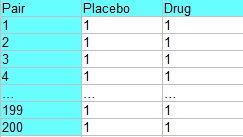Statistics Definitions > Matched Samples
What are Matched Samples?
 Matched samples (also called matched pairs, paired samples or dependent samples) are paired up so that the participants share every characteristic except for the one under investigation. A “participant” is a member of the sample, and can be a person, object or thing. A common use for matched pairs is to assign one individual to a treatment group and another to a control group. This process, called “matching” is used in matched pairs design. The “pairs” don’t have to be different people — they could be the same individuals at different time. For example:
Matched samples (also called matched pairs, paired samples or dependent samples) are paired up so that the participants share every characteristic except for the one under investigation. A “participant” is a member of the sample, and can be a person, object or thing. A common use for matched pairs is to assign one individual to a treatment group and another to a control group. This process, called “matching” is used in matched pairs design. The “pairs” don’t have to be different people — they could be the same individuals at different time. For example:
- The same study participants are measured before and after an intervention.
- The same study participants are measured twice for two different interventions.
The opposite of a matched sample is an independent sample, which deals with unrelated groups. While matched pairs are chosen deliberately, independent samples are usually chosen randomly (through simple random sampling or a similar technique).
Purpose
The purpose of matched samples is to get better statistics by controlling for the effects of other “unwanted” variables. For example, if you are investigating the health effects of alcohol, you can control for age-related health effects by matching age-similar participants.
Tests
When you run a hypothesis test, you have to choose a test specifically for either independent samples or dependent (paired) samples. Paired samples can be analyzed with the following specific tests:
- The McNemar test is a non-parametric (distribution free) test for paired nominal data.
- The paired sample t test (also called a “related measures” t-test or dependent samples t-test) compares the means for the two groups to see if there is a statistical difference between the two.
- The Wilcoxon signed rank testis non-parametric alternative to the t-test. Note that this test doesn’t compare means, it compares mean ranks.